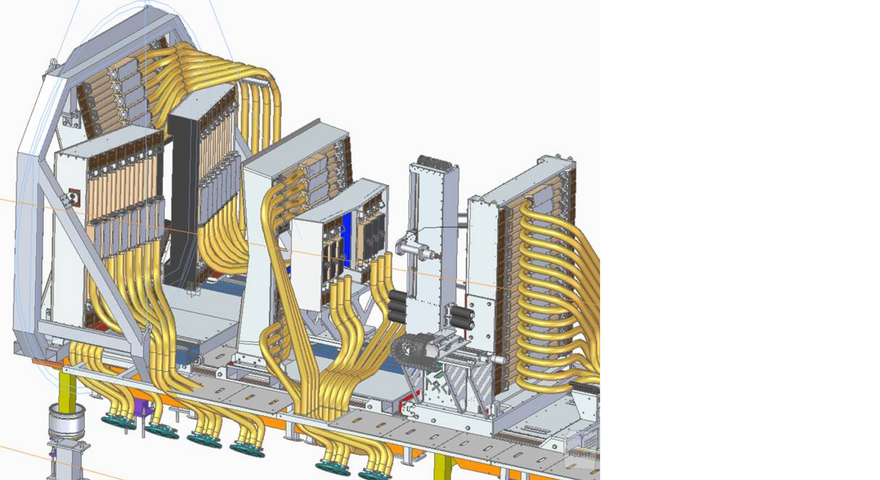Case-Study Case-Study, Neutron Detector, Large Experiment, ESS
Introduction
Loki Experiment is a new instrument at the European Spallation Source (ESS) in Lund, Sweden. It is a high-performance Small Angle Neutron Scattering (SANS) instrument that will provide a unique capability for the study of complex materials and biological systems. The instrument is designed to deliver high neutron flux and high resolution over a wide range of scattering vectors, enabling the investigation of a broad range of samples.
The CAEN R5560 digitizer is a 16-channel, 14-bit, 125 MS/s digitizer that is used in the Loki Experiment to straw tubes analog signals.
The firmware of the entire system has been developed using the Sci-Compiler tool, which allows the scientist to program the FPGA of the digitizer in a graphical way.
This talk is recorded at the PSND 2024 conference in Oxford
Unveiling the Technical Triumphs of LoKI Instruments at the European Spallation Source
The world of neutron scattering is witnessing a remarkable evolution thanks to the collaborative efforts of international research facilities and cutting-edge technological firms. Today, I dive into the specifics of the LoKI Instruments’ readout electronics, a pivotal component in neutron scattering experiments at the European Spallation Source (ESS). This detailed exploration not only highlights the device’s innovative design but also underscores the thriving collaboration among major scientific entities.
Introduction to LoKI Instruments
LoKI, a small-angle neutron scattering (SANS) device, stands as a testament to successful cooperation between the European Spallation Source, ISIS Muon Neutron Source, Nuclear Instruments, and CAEN. Designed to probe the structure of materials at the nanoscale, LoKI’s readout electronics play a critical role in converting neutron interactions into valuable scientific data.
The Core of LoKI: Readout Electronics
The heart of LoKI lies in its sophisticated front-end electronics. These are crucial for accurately capturing and converting the analog signals generated by neutron interactions into a digital format that can be further processed and analyzed. The system consists of numerous readout elements integrated into a comprehensive assembly that facilitates efficient data handling and analysis.
Detector Design and Functionality
The detectors, approximately 1,000 aluminum tubes each containing seven straw tubes coated with boron, are engineered to convert neutrons into electrical signals. These straw tubes enhance both the sensitivity and resolution of the measurements, crucial for detailed material characterization.
Innovative Readout System
The unique aspect of the LoKI readout system is its ability to reduce complexity without compromising performance. Originally requiring 14 preamplifier and digitizer channels per tube, a clever design adaptation using a voltage divider has cut this number down to four. This innovation not only simplifies the system but also significantly reduces costs and increases the feasibility of scaling up the technology.
Data Processing Excellence
Once the analog signals are captured, they undergo digital conversion, followed by a sophisticated data processing routine. The backend electronics are adept at collecting data from multiple readout devices, which is then streamed via Kafka into a comprehensive data management system encompassing file writing, storage, and analysis tools. The firmware of the R5560 has been developed using the Sci-Compiler tool, which allows the scientist to program the FPGA of the digitizer in a graphical way
High-Performance Specifications
LoKI’s detectors demonstrate impressive efficiency and positional resolution, vital for high-precision measurements. The system can handle a particle interaction rate of up to 400 kHz with 6mm space resolution, with a capability to maintain performance even at rates as high as 2.3 MHz under certain conditions.
Future Prospects and Impact
As we look to the future, the scalable and adaptable design of the LoKI readout electronics paves the way for their application in other neutron scattering instruments. The ongoing development and refinement of these systems promise to enhance our understanding of material structures, opening new avenues for scientific discovery and technological advancement.
Conclusion
The development of LoKI’s readout electronics at the European Spallation Source is a prime example of international cooperation in the realm of scientific research. By leveraging advanced engineering and technological innovations, researchers are equipped with tools that push the boundaries of neutron scattering applications. This endeavor not only underscores the importance of collaborative approaches in scientific advancements but also sets a benchmark for future projects in the neutron scattering community.
Thank you for joining me in this detailed examination of a cornerstone of modern neutron science. The journey of LoKI at the ESS continues to inspire and drive forward the field of material science and engineering.


